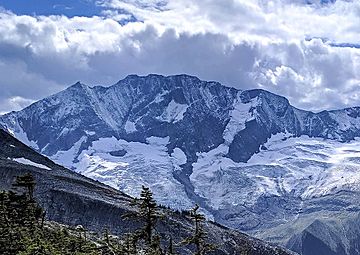Mount Bonney facts for kids
Quick facts for kids Mount Bonney |
|
|---|---|

Mount Bonney featuring Bonney Glacier
|
|
| Highest point | |
| Elevation | 3,100 m (10,200 ft) |
| Prominence | 750 m (2,460 ft) |
| Parent peak | Mount Sir Donald (3284 m) |
| Listing | Mountains of British Columbia |
| Geography | |
| Location | Glacier National Park British Columbia, Canada |
| Parent range | Selkirk Mountains |
| Topo map | NTS 82N/04 |
| Climbing | |
| First ascent | 1888 William S. Green, Henry Swanzy |
| Easiest route | Scrambling YDS 3 |
Mount Bonney is a tall mountain peak located in Glacier National Park in British Columbia, Canada. It is part of the Selkirk Mountains. This mountain stands about 3,100 meters (10,170 feet) high.
Mount Bonney is surrounded by a lot of ice. This includes the Bonney Glacier, Clarke Glacier, Swanzy Glacier, and a large snowfield called Bonney Névé. The closest taller mountain is Mount Sir Donald, which is about 10 kilometers (6 miles) to the northeast. You can easily see Mount Bonney from Highway 1, also known as the Trans-Canada Highway, especially when you are near Rogers Pass.
Contents
Exploring Mount Bonney's Past
First Climbers Reach the Top
The first time people successfully climbed to the very top of Mount Bonney was in 1888. Two reverends, William S. Green and Henry Swanzy, made this important climb. A "reverend" is a title for a religious leader, often in a Christian church.
How Mount Bonney Got Its Name
Mount Bonney, along with the Bonney Glacier and Bonney Névé, were all named in 1888. Reverend Green chose these names to honor Thomas George Bonney. Thomas Bonney was a very important person. He was the president of the Geological Society of London and also led the Alpine Club of London.
The name "Mount Bonney" was officially accepted in 1932. This happened when the Geographical Names Board of Canada approved it.
Weather Around Mount Bonney
Understanding the Climate
Mount Bonney has a subarctic climate. This means it has very cold winters with lots of snow. The summers are usually mild, not too hot. Temperatures can drop below -20 degrees Celsius (-4 degrees Fahrenheit). With the wind, it can feel even colder, sometimes below -30 degrees Celsius (-22 degrees Fahrenheit).
Water Flow from the Mountain
Rain and melting snow from the mountain flow in two main directions. Some water drains north into the Illecillewaet River. Other water flows south into the Incomappleux River.



